 Robert
Matzinger's Cycling Trans-Labrador Highway Pages
Robert
Matzinger's Cycling Trans-Labrador Highway Pages  Robert
Matzinger's Cycling Trans-Labrador Highway Pages
Robert
Matzinger's Cycling Trans-Labrador Highway Pages
Cycling Trans-Labrador Highway
The whole thing started with a conference near New York, which I had to attend for professional reasons. So why not buy a second ticket for my wife, take our cycles with us and go for a bicycle tour somewhere in the east of the American continent. However we knew that it's quite hot in summer near New York (and we can't stand the heat when cycling). We would have to go north to find a more desirable climate. So northwards we went with the fingers on the map and - oops - we found a very empty area on the map labelled Labrador and for thousands of square miles we saw there's just this one and only road called Trans-Labrador Highway. This was a challenge! We canceled some more convenient alternatives in Nova Scotia and Newfoundland, 'cause this lonely road didn't want to go out of our minds. We didn't know anything in advance about it. Will it be cyclable at all? How are the road conditions? How are the distances?
So we started collecting information and preparing for this trip. We're no newbies in cycling (see e.g. our Karakoram Highway-pages), but we knew this will be a rather exhausting trip and we went prepared for not always pleasant conditions.
By the way: Preparations also included a lot of conversation with people on the net, who provided important and necessary tips (beside warning us to try this trip at all). The mere existence of this site should be understood as a way to say "thank you" to all those friendly people who helped us along.
The journey begins. The conference has ended, New York has been sight-seen sufficiently, a car has been rented, the bikes have been placed on the back seats, so here we go. We drive towards Quebec City, the actual starting point of the cycle tour. It's awfully hot and humid and we're glad we go northward.
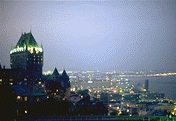
After a hot night sleeping in the car (oh these mosquitoes!) the day gets even hotter. We reach Quebec City in the afternoon and hurry to do some food shopping before we have to return the car. Quebec City is rather nice and the view of the St. Laurent river is really fine.
The cycle tour starts. We are glad the preparations are over and we
are on the bikes finally. However, although we carefully planned and prepared
our equipment, we didn't have any time left for training. So we start slowly.
We get totally soaked the first day, but after that the weather turns to
unbearable hot.
As usual on such tours, the pain from sitting on the cycles saddle reaches
its awful maximum on the third day (where it virtually presses tears into
my eyes). However on the fourth day the saddle and my back-side got used
to each other and the pain disappears totally for the rest of the tour.
Beside that the landscape is not very hilly and wonderfully peaceful here.
As there is a separate freeway, we have the local roads for ourselves,
which makes cycling a real pleasure here.
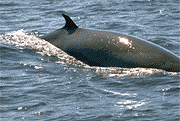 We
cross the St. Laurent River to St. Simeon. The northern shore is much more
hilly and our daily km's decrease a lot. Moreover there's just this one
road and traffic is very heavy, which makes this the most dangerous part
of our journey. We build ourselves red warning flags, which we put out
a meter to the left to force the cars and the heavy trucks to keep at least
a little distance when overtaking us with about 100km/h (I must say
that in NO country I visited by bike I have yet encountered such
reckless and dangerous drivers - sorry, but this is true).
We
cross the St. Laurent River to St. Simeon. The northern shore is much more
hilly and our daily km's decrease a lot. Moreover there's just this one
road and traffic is very heavy, which makes this the most dangerous part
of our journey. We build ourselves red warning flags, which we put out
a meter to the left to force the cars and the heavy trucks to keep at least
a little distance when overtaking us with about 100km/h (I must say
that in NO country I visited by bike I have yet encountered such
reckless and dangerous drivers - sorry, but this is true).
We go for one of these whale-watching tours and are really impressed by
the amounts of whales we can see. A day of wind from the back pushes us
towards Baie-Comeau, which we reach quite wet on a bad-weather day.
 This
day we start our crossing of Northern Quebec and Labrador - sloppily called
the Trans-Labrador Highways, although the first half of it solely belongs
to Quebec. In the morning it takes us a while to get started, because we
have to buy all food and supply for appropriately the next two weeks. Although
paved, the road has an awful lot of extremely steep sections, which reminds
us of our cycling tours to the Alps and to the Pyrenees. We just can't
get many km's done. The road mostly takes us through wood-land, so there's
not so much landscape to see. In the early afternoon we pass the Maniq
II power plant. Quite tired we pitch our tent at about km65 at a stony
little plateau with a nice view. Black flies and mosquitoes make cooking
a bit uncomfortable for Veronika.
This
day we start our crossing of Northern Quebec and Labrador - sloppily called
the Trans-Labrador Highways, although the first half of it solely belongs
to Quebec. In the morning it takes us a while to get started, because we
have to buy all food and supply for appropriately the next two weeks. Although
paved, the road has an awful lot of extremely steep sections, which reminds
us of our cycling tours to the Alps and to the Pyrenees. We just can't
get many km's done. The road mostly takes us through wood-land, so there's
not so much landscape to see. In the early afternoon we pass the Maniq
II power plant. Quite tired we pitch our tent at about km65 at a stony
little plateau with a nice view. Black flies and mosquitoes make cooking
a bit uncomfortable for Veronika.
We take dinner at "Maniq Outardes", a huge transformer station with a dusty rest-stop containing a minor restaurant. We feel an incredible contrast to the wild we just came from. The rest of the day keeps us busy with steep road sections. In the afternoon it gets awfully hot and I enjoy a bath in one of those nameless little rivers. At night we don't sleep well because of some unidentifiable noise from the woods.
It's cool and overcast from the morning on. I try (and enjoy) my
new warmer cycling trousers, which will become kind of a second skin later
on this journey. The amount of hills decreases a bit, but is still considerable.
Under the overcast sky the landscape looks very sad and melancholic. Just
before lunch time it starts raining, so lunch is skipped. We hurry to reach
the Maniq V power plant in time for the last guided tour.  The
staff of Maniq V gives us a heartwarming welcome and the tour is very impressive
(although we don't see much outside, because the weather is awful). We
sleep in a small Motel with an awful restaurant two km (and a steep hill) back
towards Baie-Comeau.
The
staff of Maniq V gives us a heartwarming welcome and the tour is very impressive
(although we don't see much outside, because the weather is awful). We
sleep in a small Motel with an awful restaurant two km (and a steep hill) back
towards Baie-Comeau.
We are allowed to use the normally closed paved road left of the dike (the public road to the right is unpaved and very steep) and to cross the dike with the bikes, which provides a wonderful view of the whole construction. Then the road starts to be gravel. We are curious about how we are going to do on gravel, but it's the many extremely steep grades that turn out to be the major problem. Up and up and up we cycle. Too slowly for our plans (but slow enough for some clouds of black flies to catch us when going upwards). In the afternoon it starts raining and the road feels like cycling in chewing-gum. When rain decreases, the black flies get really nasty. We pitch our tent just near the road on a muddy, but flat spot and are glad for a little wind that eases our black-fly problem. Very tired, we fall asleep soon.
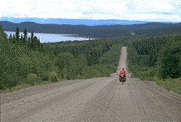 It's
wet in the morning and we need a while till we have stuffed our wet tent
into our bags. The road gets a bit better, as does our mood. We get some
wonderful views of the Maniq V reservoir and the surrounding landscape.
Endless straight sections of road lead to the horizon. Still many of them
go uphill. For a late lunch we reach Relais Gabriel which turns out to
be nothing more than a fuel station with a little restaurant. We complete
our food reserve with some bread and cycle into the afternoon. Todays campspot
has some nice views of the landscape. Again there are lots of black flies,
but we more and more get used to it.
It's
wet in the morning and we need a while till we have stuffed our wet tent
into our bags. The road gets a bit better, as does our mood. We get some
wonderful views of the Maniq V reservoir and the surrounding landscape.
Endless straight sections of road lead to the horizon. Still many of them
go uphill. For a late lunch we reach Relais Gabriel which turns out to
be nothing more than a fuel station with a little restaurant. We complete
our food reserve with some bread and cycle into the afternoon. Todays campspot
has some nice views of the landscape. Again there are lots of black flies,
but we more and more get used to it.
After a cold night there are incredible impressions in the morning when
the sun comes up and mirrors itself in thousand little drops of water the
night dew has left on every leaf and grass. We enjoy having breakfast in
this cool hour before the black flies come out. The road has already been
worse and I cycle like with an auto-pilot. At km 353 it seems we have
left the mountains - road and landscape become more or less flat. We hastily
interrupt our lunch break as we cannot stand the myriads of black flies
we encounter. 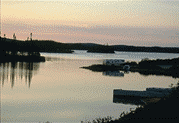 In
the evening we get on paved road again. Even sidewalks do exist and there's
a huge open area with just grass and no trees and bushes. Later we learn
that this was Gagnon, a mining town with about 3000 inhabitants. It was
leveled just a couple of years ago. There's virtually nothing left. Passengers
tell us different stories about why this town was elliminated. We can't
assemble a consistent "truth" from the conflicting reports. It
feels a bit spooky to camp here, however our campspot at the river flowing
here is extremely nice. I enjoy having a bath (and the black flies
enjoy feeding on me until I get back into my clothes) and someone
gives us some freshly caught trout for dinner which we enjoy thoroughly
(they are just a little bit difficult to eat when wearing a headnet) while
an incredible sunset contributes even more to the general enjoyment.
In
the evening we get on paved road again. Even sidewalks do exist and there's
a huge open area with just grass and no trees and bushes. Later we learn
that this was Gagnon, a mining town with about 3000 inhabitants. It was
leveled just a couple of years ago. There's virtually nothing left. Passengers
tell us different stories about why this town was elliminated. We can't
assemble a consistent "truth" from the conflicting reports. It
feels a bit spooky to camp here, however our campspot at the river flowing
here is extremely nice. I enjoy having a bath (and the black flies
enjoy feeding on me until I get back into my clothes) and someone
gives us some freshly caught trout for dinner which we enjoy thoroughly
(they are just a little bit difficult to eat when wearing a headnet) while
an incredible sunset contributes even more to the general enjoyment.
 It's
crazy. Here in the middle of nowhere lies an 80 km piece of paved road,
unconnected to any other paved road on earth and not adjacent to any settlement.
There's almost no traffic, it's almost flat and we just let the bikes roll
and roll like they did not for days. A deeply blue sky spawns 180 degrees
above us. Virtually no mountains are visible at any horizon. It's really
wonderful, as if the road belongs to us. Just a dozen km's of burnt wood
make for some spooky atmosphere. In the afternoon we reach Fire Lake, a
former iron mine, totally shut down and closed today (it is the cause for
the road: to enable access to the mine from Gagnon). From there the gravel
starts again. The gravel is seriously bad here and we often have to stop
when being totally covered in a dust cloud from a passing-by truck. 12
km after Fire Lake we pitch our tent at a nice spot near a lake. It's peaceful
here, just the road is a bit too near so we catch some noise and dust.
A bit of wind eases the black fly plague.
It's
crazy. Here in the middle of nowhere lies an 80 km piece of paved road,
unconnected to any other paved road on earth and not adjacent to any settlement.
There's almost no traffic, it's almost flat and we just let the bikes roll
and roll like they did not for days. A deeply blue sky spawns 180 degrees
above us. Virtually no mountains are visible at any horizon. It's really
wonderful, as if the road belongs to us. Just a dozen km's of burnt wood
make for some spooky atmosphere. In the afternoon we reach Fire Lake, a
former iron mine, totally shut down and closed today (it is the cause for
the road: to enable access to the mine from Gagnon). From there the gravel
starts again. The gravel is seriously bad here and we often have to stop
when being totally covered in a dust cloud from a passing-by truck. 12
km after Fire Lake we pitch our tent at a nice spot near a lake. It's peaceful
here, just the road is a bit too near so we catch some noise and dust.
A bit of wind eases the black fly plague.
After a rainy night it clears up in the morning. The gravel road is
unbelievably bad. It's more like swimming in gravel than cycling. The
road is made of loose stones, often the size of a man's fist. Moreover
they built incredibly steep grades into this road (seems to be an art form
in this flat landscape). It's awfully dusty and we often have to stop in
the trucks dust clouds. Sand gets everywhere, we can taste it and hear
it crunching between our teeth. It's very strenuous for the mind to keep
balance on the bikes and to avoid the worst holes in the road. 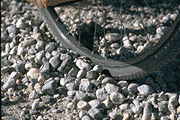 Near
Fermont truck traffic gets more and more heavy (every truck means a dust
bath) and the gravel gets so bad, that we have to walk and push the
bikes for some stretches. We catch some interesting views of the Fermont
mine, but the road stays catastrophic with even more traffic and worse
gravel from road construction sections. In the late evening we get on pavement
again. We feel really exhausted. It's just another paved 27 km to Fermont,
which we cycle like in trance. Fermont is built into the (wind-)shadow
of a huge community building called the "wall". There's only
one hotel in Fermont (in the wall, where else), so we don't need long to
find a room in Fermont. What a contrast to the wilderness we just came
from: a hotel, supermarkets (visit the wall!), a restaurant (in the
wall), a hot shower, a big room... We have some difficulties realizing
where we are. As there is also just one restaurant, there's no difficulty
in the choice of where to go to dinner. We feel very tired and empty, but
quite satisfied about having made it till here. We sleep like dead.
Near
Fermont truck traffic gets more and more heavy (every truck means a dust
bath) and the gravel gets so bad, that we have to walk and push the
bikes for some stretches. We catch some interesting views of the Fermont
mine, but the road stays catastrophic with even more traffic and worse
gravel from road construction sections. In the late evening we get on pavement
again. We feel really exhausted. It's just another paved 27 km to Fermont,
which we cycle like in trance. Fermont is built into the (wind-)shadow
of a huge community building called the "wall". There's only
one hotel in Fermont (in the wall, where else), so we don't need long to
find a room in Fermont. What a contrast to the wilderness we just came
from: a hotel, supermarkets (visit the wall!), a restaurant (in the
wall), a hot shower, a big room... We have some difficulties realizing
where we are. As there is also just one restaurant, there's no difficulty
in the choice of where to go to dinner. We feel very tired and empty, but
quite satisfied about having made it till here. We sleep like dead.
In the morning we spend a couple of hours to cycle around in Fermont
to catch some atmosphere of the town.  We
talk to some people to realize that none of the homes are owned by its
inhabitants - everything belongs to the company. Many people here look
to Gagnon to get an idea of what will happen to Fermont after the iron
is finished and the mine is closed. This fact, the remoteness of town,
the fact that it has not developed by itself, but was just planned on some
architects drawing board, a bit of a worn-out appearance of some homes,
and the omnipresent shadow of the wall make for a desperate and exposed
atmosphere like on an oil-drilling platform. Slowly we cycle the 22 km
to Labrador City.
We
talk to some people to realize that none of the homes are owned by its
inhabitants - everything belongs to the company. Many people here look
to Gagnon to get an idea of what will happen to Fermont after the iron
is finished and the mine is closed. This fact, the remoteness of town,
the fact that it has not developed by itself, but was just planned on some
architects drawing board, a bit of a worn-out appearance of some homes,
and the omnipresent shadow of the wall make for a desperate and exposed
atmosphere like on an oil-drilling platform. Slowly we cycle the 22 km
to Labrador City.
It's one of the best jokes on earth that these two towns, just 22km apart
and separated from every other settlement on earth by about 600km of bad
gravel road (beside Wabush 10km from Lab City and the 2000 inhabitant town
of Churchill Falls) do not only have different languages, which are
NOT in general mutually understood; they do also have different
time!!! So people living in Lab City and working in Fermont do wear
two different watches! Sorry, nationalists, but this seems really silly.
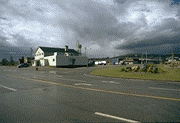 In
contrast to Fermont, Labrador City appears like a real little town. Nice,
clean and openly built. We are still terribly tired. The tourist info in
Lab City (yes there is one!) is friendly and helpful. In the evening we
each kill a nice big pizza to fill the emptiness in our stomaches.
In
contrast to Fermont, Labrador City appears like a real little town. Nice,
clean and openly built. We are still terribly tired. The tourist info in
Lab City (yes there is one!) is friendly and helpful. In the evening we
each kill a nice big pizza to fill the emptiness in our stomaches.
After sleeping long, we visit the Wabush mine, just 10km from Lab City. People cannot believe where we came from and that we did it on bikes. At the guided tour, we have some difficulties with our vocabulary, but still enjoy insights of the factory buildings and a sight of the big trucks. We're still tired. In the afternoon I fall asleep and almost can't get myself up for going to lunch.
It's raining all day long and it got quite cold. We manage to buy ourselves
some flight tickets out of St. Johns/Nfld. So now we have to get there
somehow.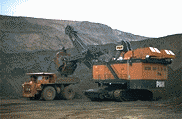
We wanted to leave Labrador City today, but it's raining cats and dogs. I take the opportunity to service our bikes. Everything's more or less all-right, only Veronika's back wheel has a serious figure eight (is this the word?). It takes me some time to distribute the tension in the wheel among the spokes. In the afternoon we get on a bus-tour to the Lab City mines. These are the biggest and we drive almost an hour through the mine. The dimension of the mining here is absolutely breathtaking.
After a shopping tour (food for the next weeks), which takes longer
than expected, we leave Labrador City. 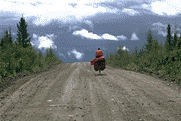 A
strange feeling of sadness overcomes me as we are now leaving the place
that took such a hardship to get here. It's interesting how the signs of
culture (noise, dust, ...) gradually fade away and we cycle back into the
wilderness. Near Labrador City the gravel road is often heavy washboard.
We have approximately 250km of nothing to Churchill Falls before us. The
weather is "striped" as we call it. So it's raining,sunny
and raining again all the time. Often it doesn't make sense to get into
the raining equipment - we are better off to just keep cycling and let
us dry after the shower is over. At the crossing with the railway to Shefferville
we expected some kind of train station, but there's absolutely nothing
than the railway tracks. Our time-plan is rather tight now, so we keep
cycling until the late evening.
A
strange feeling of sadness overcomes me as we are now leaving the place
that took such a hardship to get here. It's interesting how the signs of
culture (noise, dust, ...) gradually fade away and we cycle back into the
wilderness. Near Labrador City the gravel road is often heavy washboard.
We have approximately 250km of nothing to Churchill Falls before us. The
weather is "striped" as we call it. So it's raining,sunny
and raining again all the time. Often it doesn't make sense to get into
the raining equipment - we are better off to just keep cycling and let
us dry after the shower is over. At the crossing with the railway to Shefferville
we expected some kind of train station, but there's absolutely nothing
than the railway tracks. Our time-plan is rather tight now, so we keep
cycling until the late evening.
Despite the gravel road, the bikes are rolling nicely today. We can make incredible 100km's (our record on gravel) and I sometimes dare to do 40km/h downhill. It's raining some times, but not too long. The road is rather flat, we have left the last hills shortly after Lab City. In endless straight sections the road crosses the plains of this land. We camp in a wood-fire zone, which makes for bit of spooky atmosphere. There are lots of mosquitoes and black flies, which are obviously not bothered by the cold. I spend some time to redistribute the tension in our wheels among the spokes.
Weather is better today. Gravel is rather good, so we go smoothly on
those endless straights. No mountains, no hills are anywhere visible, just
360 degrees of even horizon. At lunch we reach the Esker road junction
(i.e. where the road to Esker meets the TLH). From here on the road gets
very bad for us. Deep gravel with fist-size loose stones, washboard everywhere
and it's also hilly again. We hurry towards Churchill Falls for an opportunity
to visit the power-plant there, because we know we mustn't loose a day
for that, otherwise our plans for reaching Goose Bay in time are spoiled.
The road shakes the souls out of us. We can hardly look at something different
than our front wheel, so we almost miss the Churchill Falls, once one of
the biggest waterfalls of the continent, but dry today because of the power
plant.  Exhausted
we reach Churchill Falls. Now this town is really like an oil-drilling
platform. Everything's planned here and everyone just lives for the power
plant. The remoteness (i.e. at least 250km wilderness in every direction)
can almost be smelled. Still everything is nice and modern and the town
appears to be well-equipped. There's only one hotel, so we don't have an
alternative to taking a rather expensive room. With a lot of luck we indeed
get on a tour to the under-surface power plant for which this town exists.
It's incredibly big and we are deeply impressed by the dimensions of the
construction (I remember they have about 17km of under-surface road alone).
At about midnight we get "home" to our hotel room and we sleep
like dead.
Exhausted
we reach Churchill Falls. Now this town is really like an oil-drilling
platform. Everything's planned here and everyone just lives for the power
plant. The remoteness (i.e. at least 250km wilderness in every direction)
can almost be smelled. Still everything is nice and modern and the town
appears to be well-equipped. There's only one hotel, so we don't have an
alternative to taking a rather expensive room. With a lot of luck we indeed
get on a tour to the under-surface power plant for which this town exists.
It's incredibly big and we are deeply impressed by the dimensions of the
construction (I remember they have about 17km of under-surface road alone).
At about midnight we get "home" to our hotel room and we sleep
like dead.
At this point I should explain that we were cheating ourselves all the time on this journey. Before Lab City we just wanted to make it there and then quit cycling. Then we persuaded ourselves to keep cycling until Churchill Falls with the idea of hitchhiking the last section. Now we get ambitious. We already did it so far and we feel we will never cycle this road from Quebec City until here again. So cycling on or quitting makes for the fundamental difference of having the TLH done or having it almost done. We are really short of time, but if we can do it to Goose Bay in three days - success. This is our last chance of finishing what we have started and we don't want to miss that chance. In Newfoundland everything's going to be paved, so we currently don't worry about that.
This is the motivation that makes us get up early despite the fact that
it's raining cats and dogs outside again. The road from here on is called
the "Trans-Labrador Cow Path" by the local people. Indeed there
is everything a cyclist's nightmare could contain: washboard, potholes,
gravel, sand, steep grades - you name it, it'll be there. And it's narrow
and winding all the time. Shortly after Churchill Falls we meet a motor-cyclist
coming from Goose Bay. He already fell 5 or 6 times. 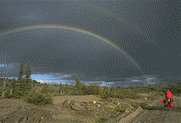 Still
we can go around all the potholes (the cars can't) and we keep cycling.
Our bikes seem to be gradually falling apart and I have a hard time
to keep them going. What worries me most is Veronikas back wheel in which
there's an always increasing figure eight. I have to stop several times
to even out the tension in the spokes to keep them from breaking, which
is not so much fun in one of those rain-showers. The gearshifts and chains
are also near to quitting. Still the ever-changing weather makes for unforgetable
moods. In the afternoon we leave the inner plateau of Labrador and the
road gets more hilly again. Some sections are terribly steep, but we find
the gradual change in the landscape very attractive. Good camp-spot above
a nice river-valley. Myriads of black flies as usual.
Still
we can go around all the potholes (the cars can't) and we keep cycling.
Our bikes seem to be gradually falling apart and I have a hard time
to keep them going. What worries me most is Veronikas back wheel in which
there's an always increasing figure eight. I have to stop several times
to even out the tension in the spokes to keep them from breaking, which
is not so much fun in one of those rain-showers. The gearshifts and chains
are also near to quitting. Still the ever-changing weather makes for unforgetable
moods. In the afternoon we leave the inner plateau of Labrador and the
road gets more hilly again. Some sections are terribly steep, but we find
the gradual change in the landscape very attractive. Good camp-spot above
a nice river-valley. Myriads of black flies as usual.
It was raining the whole night long. It's still raining in the morning
when we decide to pack our tent. It's awfully cold, but the steep grades
that bring us back to the Labrador plateau warm us up quickly. However
it doesn't get flat then. Despite the flat landscape, the road goes steeply
up and down all the time. It's quite frustrating when you see your road
far at the horizon, but have to make dozens of steep hills to get there.
On the other hand we find plenty of good view-points to catch the landscape's
beauty that is indeed breathtaking at many spots.  The
ups-and-downs considerably slow us down. We adopt the idea that this road
must have been built by a drunken caterpillar driver who didn't want to
miss any hill or any steep section in this flat landscape. We meet a truck
driver in a big fuel truck, who tells us that he is now going to spend
the next 24 hours to do the 120km to Churchill Falls (this should give
you an impression of the road quality). It's raining frequently this day
and we skip our lunch as it's too cold to rest anyway. Desperately we keep
cycling until the late evening as we do not want to spoil our chances to
reach Goose Bay tomorrow. It's almost dark and it's raining again when
we pitch our tent (it's still soaked from the morning). Our stove goes
on strike and I need an hour sitting outside in the pouring rain and
repairing it. We feel exhausted and fed up. This land can be so beautiful,
why must it be so nasty and harsh at the same time.
The
ups-and-downs considerably slow us down. We adopt the idea that this road
must have been built by a drunken caterpillar driver who didn't want to
miss any hill or any steep section in this flat landscape. We meet a truck
driver in a big fuel truck, who tells us that he is now going to spend
the next 24 hours to do the 120km to Churchill Falls (this should give
you an impression of the road quality). It's raining frequently this day
and we skip our lunch as it's too cold to rest anyway. Desperately we keep
cycling until the late evening as we do not want to spoil our chances to
reach Goose Bay tomorrow. It's almost dark and it's raining again when
we pitch our tent (it's still soaked from the morning). Our stove goes
on strike and I need an hour sitting outside in the pouring rain and
repairing it. We feel exhausted and fed up. This land can be so beautiful,
why must it be so nasty and harsh at the same time.
An incredible morning. We get up very early. The sun shines in a flat
angle through the morning fog and makes the dew drops on every grass and
leaf shine like millions of little diamonds. When cycling, we almost forget
to watch out for the potholes. It's like inner Labrador wants to say "goodbye" to
us. There's smooth going for a while. However they are currently rebuilding
the road and the construction areas are the worst to cycle. Deep mud, loose
gravel and heavy truck traffic from the construction sites keep us busy
for some dozen km's. What a feeling when cycling steeply upwards in chewing-gum-like
mud with a roaring construction truck behind you! We must keep going to
reach Goose Bay today. And we want to cycle it ourselves. Queens song "Nothing's
going to stop us now" doesn't go out of my head. At about lunch
we reach the border of the Labrador plateau. All of a sudden the construction
site is over and a newly built smooth gravel road leads downhill nicely.
We feel like on a highway and enjoy to speed downwards with amazing 40km/h.
Our hope to reach Goose Bay rises, but it falls again when we realize that
the newly built section is over after about 10 km. The landscape has changed
dramatically. We're now in a valley again and for the first time after
Relais Gabriel there are considerable hills and mountains at the horizon
again. It also got warmer down here and the air smells quite different.
Rain shower frequency decreases and towards the afternoon it gets really
sunny. Despite potholes, stones and washboard do still exist, the road
is not that bad now. Some sections are still terribly steep, but not so
many. 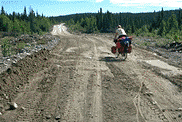 The
new feature found here are sand-holes. They look just like the surrounding
hard-pressed sand, but the front wheel dives in and looses any steerability.
If you don't manage to get back on hard ground, you can only leave the
bike quickly. 45 km before Goose Bay we get on a newly built road section
again (good gravel) and enjoy cycling smoothly and straight, but it's over
again soon. This seems to be a general feature of this land: Joy is
very intense here, but never lasts long. In the evening we have our 100km.
We take a nice long break for dinner to regain power to cycle into the
night to finish the TLH today. It's getting dark and we put on our
headlamps and keep cycling. There are some more steep grades, but more
or less the road's flat now. It's strange to cycle the washboard sections
with headlamps. In general it's hard to keep balance in the dark, which
is worsened by our increasing exhaustion. I have to stop frequently
to let a feeling of dizziness go away. Towards Goose Bay the road gets
worse and worse with lots of sand holes and washboard sections coming from
the increasing local traffic. During the night you can't see the sand holes,
so often out of a sudden the bike swings away under me. I fall five times
on this section alone, but the sand makes for a soft landing so neither
me nor the bike gets damaged. For hours we just cycle behind the spot-lights
of our headlamps. Then like in trance we realize that we can see the first
lights of Goose Bay. At midnight we are back on paved road. We did it.
We finished cycling TLH. We're too exhausted to feel joy and satisfaction
currently. A nice lady has invited us to sleep at her home despite we warned
her we will not appear before midnight (thank you, thank you, thank you!).
Slowly we cycle the last meters to find that house. Now on the pavement
we realize how our bikes are screeching and aching from the sand. At the
house, indeed someone opens up and we are invited to stay for the night.
A hot shower and a bed can mean so much! This night I don't sleep
a lot, I'm too overwhelmed by the impressions of the last days. However
tomorrow there will be no cycling anymore.
The
new feature found here are sand-holes. They look just like the surrounding
hard-pressed sand, but the front wheel dives in and looses any steerability.
If you don't manage to get back on hard ground, you can only leave the
bike quickly. 45 km before Goose Bay we get on a newly built road section
again (good gravel) and enjoy cycling smoothly and straight, but it's over
again soon. This seems to be a general feature of this land: Joy is
very intense here, but never lasts long. In the evening we have our 100km.
We take a nice long break for dinner to regain power to cycle into the
night to finish the TLH today. It's getting dark and we put on our
headlamps and keep cycling. There are some more steep grades, but more
or less the road's flat now. It's strange to cycle the washboard sections
with headlamps. In general it's hard to keep balance in the dark, which
is worsened by our increasing exhaustion. I have to stop frequently
to let a feeling of dizziness go away. Towards Goose Bay the road gets
worse and worse with lots of sand holes and washboard sections coming from
the increasing local traffic. During the night you can't see the sand holes,
so often out of a sudden the bike swings away under me. I fall five times
on this section alone, but the sand makes for a soft landing so neither
me nor the bike gets damaged. For hours we just cycle behind the spot-lights
of our headlamps. Then like in trance we realize that we can see the first
lights of Goose Bay. At midnight we are back on paved road. We did it.
We finished cycling TLH. We're too exhausted to feel joy and satisfaction
currently. A nice lady has invited us to sleep at her home despite we warned
her we will not appear before midnight (thank you, thank you, thank you!).
Slowly we cycle the last meters to find that house. Now on the pavement
we realize how our bikes are screeching and aching from the sand. At the
house, indeed someone opens up and we are invited to stay for the night.
A hot shower and a bed can mean so much! This night I don't sleep
a lot, I'm too overwhelmed by the impressions of the last days. However
tomorrow there will be no cycling anymore.
After a wonderful breakfast (thanks again), we have some time left to
get a glimpse of Goose Bay. We catch a wonderful view of the Churchill
river in the morning sunlight. Everything is so big and far away here as
there's so mach space in this land. In Europe this town would be called
countryside, as houses are almost too far apart for convenient cycling.
We cycle a bit towards the airbase, but just see a few planes from far
away. Still we catch a breeze of the aviation pioneers. A fierce wind makes
us quit our explorations. We hurry to catch the ferry. Shortly before the
ferry station we are soaked to the skin by our last Labrador rain shower.
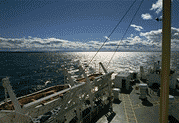 Then
we get on the ferry. A vehicle that moves without our muscular intervention! We
feel exhausted and physically empty like never before (this will not go
away for weeks). Even climbing the stairs to the upper deck is a major
effort. However now seeing Goose Bay disappear behind the horizon makes
us feel somehow melancholic. From the ship the dimensions of this land
become once more visible. It's not before the evening until we reach the
open sea. Through a fog of tiredness and sleepiness I still manage
to stay on deck to catch the last glimpse of Labrador and to see the gradual
change of landscape from the fjord to the open sea. An amazing sunset is
the benefit for not following the urge to sleep. With the last light I roll
up beside my wife in one of those sleeper chairs under deck and fall asleep
immediately.
Then
we get on the ferry. A vehicle that moves without our muscular intervention! We
feel exhausted and physically empty like never before (this will not go
away for weeks). Even climbing the stairs to the upper deck is a major
effort. However now seeing Goose Bay disappear behind the horizon makes
us feel somehow melancholic. From the ship the dimensions of this land
become once more visible. It's not before the evening until we reach the
open sea. Through a fog of tiredness and sleepiness I still manage
to stay on deck to catch the last glimpse of Labrador and to see the gradual
change of landscape from the fjord to the open sea. An amazing sunset is
the benefit for not following the urge to sleep. With the last light I roll
up beside my wife in one of those sleeper chairs under deck and fall asleep
immediately.
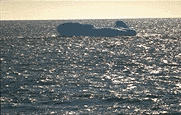 At
6am my wife wakes me up with loud "iceberg, iceberg" shouting.
Not so sure about my interest in this phenomenon, I manage to climb
the stairs to the upper deck. However even without the iceberg the sunrise
would have been fantastic. It's really cold on deck, so we go down for
breakfast (beside some coffee from the ship's restaurant, our stuff is
still from Lab City and Churchill Falls, as all the super markets were
closed in Goose Bay). We fall asleep again right after that. The rest
of the day we spend sleeping and dozing, unable to do serious things like
reading, talking or watching TV. In the afternoon the first light-houses
of Newfoundland come into view and we once again encounter this gradual
change from open sea to fjord when the vessel sails into the fjord near
Lewisport. Too soon the wonderful state of moving without effort is over.
We leave the ferry and enter Newfoundland. After some searching around
we find a wonderful campsite near a little lake.
At
6am my wife wakes me up with loud "iceberg, iceberg" shouting.
Not so sure about my interest in this phenomenon, I manage to climb
the stairs to the upper deck. However even without the iceberg the sunrise
would have been fantastic. It's really cold on deck, so we go down for
breakfast (beside some coffee from the ship's restaurant, our stuff is
still from Lab City and Churchill Falls, as all the super markets were
closed in Goose Bay). We fall asleep again right after that. The rest
of the day we spend sleeping and dozing, unable to do serious things like
reading, talking or watching TV. In the afternoon the first light-houses
of Newfoundland come into view and we once again encounter this gradual
change from open sea to fjord when the vessel sails into the fjord near
Lewisport. Too soon the wonderful state of moving without effort is over.
We leave the ferry and enter Newfoundland. After some searching around
we find a wonderful campsite near a little lake.
We wake up late. The sun heats away the cold of the night and some morning
fog, which makes an incredible light. In a bike-service hour I realize
how worn-out our bikes are. However my attempts to buy some spare parts
(especially chains) fail, so I have to manage with the material
we have. 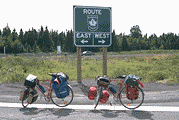 Cycling
on Trans-Canada-Highway 1 is rather boring, as this road leads around and
not through any town. We can go smoothly and quickly, but still feel very
exhausted. The emergency lanes allow easy cycling even if there's traffic.
No steep grades no potholes, no washboard. However we realize that Newfoundland
is a lot bigger than we expected (it looked so tiny on the Labrador map)
and that there are still a couple of 100km's to St. Johns. As we want to
spend some time in coastal areas, we give Gander just a very brief visit
and keep cycling until 10pm. The campgrounds are all closed in September,
but nobody worries if we still use them. We pitch our tent on a wonderful
spot in Square Pond National park.
Cycling
on Trans-Canada-Highway 1 is rather boring, as this road leads around and
not through any town. We can go smoothly and quickly, but still feel very
exhausted. The emergency lanes allow easy cycling even if there's traffic.
No steep grades no potholes, no washboard. However we realize that Newfoundland
is a lot bigger than we expected (it looked so tiny on the Labrador map)
and that there are still a couple of 100km's to St. Johns. As we want to
spend some time in coastal areas, we give Gander just a very brief visit
and keep cycling until 10pm. The campgrounds are all closed in September,
but nobody worries if we still use them. We pitch our tent on a wonderful
spot in Square Pond National park.
Once again this is a wonderful morning with the sun glistening through the morning fog. However the tiredness did not really go away during the night. We keep cycling on Highway 1. Our plan to meet the fishing town of Salvage fails due to tiredness and missing motivation. We are much more appealed by the idea of quitting cycling already at 5pm in Terra Nova National Park. We find this coastal treasure incredibly beautiful when we settle out for a light evening walk.
A rest day is more than overdue. We take a boat tour on the fjord. It's breathtaking how the sun breaks through the morning fog. Despite the absence of whales, we catch wonderful impressions of undisturbed wildlife (eagles, bird, fish, rabbits, ...). We thoroughly enjoy some light walking in the woods in the afternoon. Hunger drives us back to our tent and we conclude this lazy day with a good meal. Still a deep feeling of exhaustion does not go away.
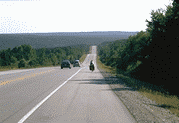 If
we want to spend some time with the little coastal fishermen villages,
we have to make up time. Actually yesterdays break was planned to bring
back the power for some more considerable distance. So we get up extremely
early and keep cycling. I give Veronika wind-shadow, so we can go
really quickly. The grades are very smooth, pavement is good, so what should
we ask for. However, even with the emergency lanes, traffic is very annoying,
as cars and trucks go by with 100km/h and more. A thunderstorm with very
heavy rain doesn't hurt us, as we flee into a restaurant (nice such things
exist here). After that it's still raining once and then and it got quite
cold. We just keep cycling. The landscape is amazingly beautiful. In the
afternoon we can catch a view of the sea on both sides of the land from
some kind of high plateau. In the late evening we have made incredible
150km. Very satisfied with ourselves we find a wonderful campground in
Belevue Beach right above the beach. It's very cold and windy, so we soon
huddle into the tent.
If
we want to spend some time with the little coastal fishermen villages,
we have to make up time. Actually yesterdays break was planned to bring
back the power for some more considerable distance. So we get up extremely
early and keep cycling. I give Veronika wind-shadow, so we can go
really quickly. The grades are very smooth, pavement is good, so what should
we ask for. However, even with the emergency lanes, traffic is very annoying,
as cars and trucks go by with 100km/h and more. A thunderstorm with very
heavy rain doesn't hurt us, as we flee into a restaurant (nice such things
exist here). After that it's still raining once and then and it got quite
cold. We just keep cycling. The landscape is amazingly beautiful. In the
afternoon we can catch a view of the sea on both sides of the land from
some kind of high plateau. In the late evening we have made incredible
150km. Very satisfied with ourselves we find a wonderful campground in
Belevue Beach right above the beach. It's very cold and windy, so we soon
huddle into the tent.
It's already raining when we wake up. The weather is depressing. Dark
clouds hang low above the sea. We can stay away of Highway 1 for a while
and cycle through lovely fishermen towns at the coast. What a difference
if you visit houses every few km's. We take some breaks for waiting out
rain showers under a solid roof. A fierce wind is against us when we cycle
towards Bonavista. It's raining cats and dogs and it's awfully cold. I
do wear two cycling trousers under my Goretex equipment. The crossing of
the Bonavista peninsula brings back a last reminder of Labrador, as we
feel to be back in deep wilderness.  Then
all of a sudden we are in civilized land as Conception bay is relatively
densely populated. It would be very romantic here, wouldn't be the ugly
weather. At the campground we get invited to a local party to chat with
some people, however the noise from the party prevents us from falling
asleep in our tent most of the night.
Then
all of a sudden we are in civilized land as Conception bay is relatively
densely populated. It would be very romantic here, wouldn't be the ugly
weather. At the campground we get invited to a local party to chat with
some people, however the noise from the party prevents us from falling
asleep in our tent most of the night.
After a cold night the weather's still bad in the morning. The villages would be so neat, but the dark low-hanging clouds give the land a depressing atmosphere. It's still nice. We enjoy the neat houses and the increasing density of settlements that enable us to wait out the worst rain showers. It's terribly cold (two pairs of trousers mandatory) and from before lunch, it doesn't stop raining anymore. We feel our general exhaustion when climbing the last long, but not steep grades before St. Johns. The view over Conception Bay is terrific, even with the low-hanging clouds. In constant rain we descend down to St. Johns. We find it rather big and it takes a while to roll through the suburbs. It's nice to go downhill, but in this weather we get frozen to the bones. However central St. Johns is built on a hill, so there are terribly steep grades to be cycled when looking for a nice bed&breakfast. We feel tired and done, still we know we did it: The whole crossing from Quebec to here by our own force. We should feel satisfied and happy, but a big portion of fish&chips, a hot shower and the fact that we can stay in a heated room this night currently mean a lot more to us. It will take a couple of days till we realize that we really concluded this tour.
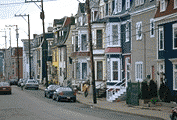 Despite
the weather is still bad, we thoroughly enjoy inhaling the atmosphere of
St. Johns. We spend a full day of walking up and down in town, visiting
museums, shopping for music,... As the town is built on a hill overlooking
a natural harbor, you can see the sea and the ships all day long. Still
we feel our general exhaustion on every stair to climb. In the evening
we set out for a walk to Signal Hill.
Despite
the weather is still bad, we thoroughly enjoy inhaling the atmosphere of
St. Johns. We spend a full day of walking up and down in town, visiting
museums, shopping for music,... As the town is built on a hill overlooking
a natural harbor, you can see the sea and the ships all day long. Still
we feel our general exhaustion on every stair to climb. In the evening
we set out for a walk to Signal Hill.  From
the hilltop we catch some extremely nice views of St. Johns and the open
Atlantic. We are reminded of another rainy and wet cycling tour in Scotland
when we think there's now just open water between us and Europe. The sun
comes out and paints everything in gold in an incredible sunset. It's already
dark (and quite cold again) when we get back to town.
From
the hilltop we catch some extremely nice views of St. Johns and the open
Atlantic. We are reminded of another rainy and wet cycling tour in Scotland
when we think there's now just open water between us and Europe. The sun
comes out and paints everything in gold in an incredible sunset. It's already
dark (and quite cold again) when we get back to town.
We decided to do this last little stretch to the airport on our bikes by ourselves. So we get up at 4am to leave St. Johns. Once again it is rather cold (maybe some 4 degrees Celsius). The early sun spotlights under deep-hanging dark clouds. We get wet again by our last Newfoundland rain shower, but between the showers some blue sky gets into vision. Just after we arrive at the airport the next rain shower hits, but this doesn't bother us anymore. All in all we feel deeply satisfied that we could conclude the tour. The wilderness, the remoteness, the size and the contradictions of this land - I will never be able to forget about that. However right now we are just glad we don't have to be out in the cold anymore. When the airplane climbs the sky, we get a nice view of Conception Bay before Newfoundland disappears under the clouds below us. We lean back and feel the deep exhaustion that will not go away for weeks. The memories and impressions from this journey, however, will never go away at all.
Robert Matzinger
The End.
When reading the diary, you may find yourself raising the question whether
this tour was really such a good idea after all. So let me state here once
and for all that we deeply got in love with this incredibly wild, vast
and remote land, so rich of undisturbed nature and unbelievable amounts
of landscape. Not to mention the heartwarming friendly people we met. Maybe
the weather, the road and the black flies are just the price for being
allowed to experience all this. However the bites of the black flies disappear
in a couple of weeks, as does the tiredness. But the impressions remain
for our lifes: memories of all the joyful, wonderful moments of this
journey, the experience of partnership of my wife and me out there in the
wild, the satisfaction of having faced the challenge we set for ourselves
and of having concluded a tour that not so many people have done. (And
we don't find a contradiction between going for a challenge and enjoying
ourselves and having a good time.) Finally we got a deep emotional experience
of how big this land actually is and how small and vulnerable we can feel
in it. We don't regret to the leastest bit we did this tour and we enjoyed
doing it.
We still write about troubles and hardships for two reasons. First they
were definitely a part of our reality on this tour. And second we want
to make clear that this is no sunday-tour (i.e. to tell people who consider
cycling/driving this route what they are facing). Still we know that a
lot tougher stuff is done in the world. Just think about the pioneers,
who explored this land solely by canoe and horseback. But that's what's
it actually all about: To find your own personal right-sized challenge
and go for it. Isn't it?
Language Disclaimer: I apologize for any misspellings and English grammar/style errors in this site. Please take into account that English is NOT my native language (the Austrian variant of German is). However I will be happy to learn about any lingual enhancements that could be made to this site.
General Disclaimer: Anything written here expresses just our humble opinion. We hope we do not offend anybody, but what we write here was seen by our own eyes, because we went there by ourselves.